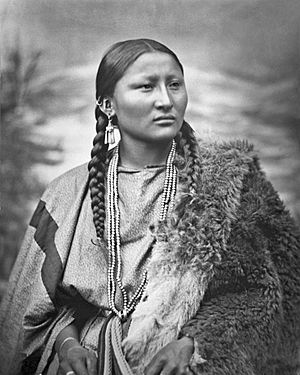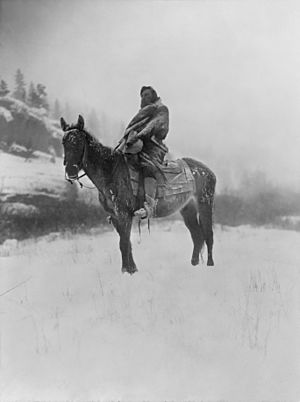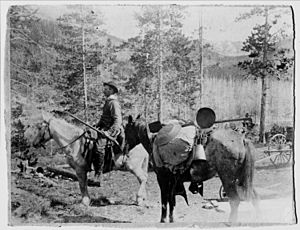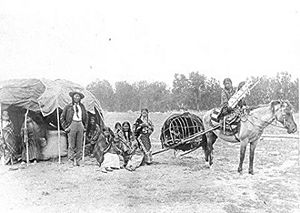History of Montana facts for kids
The history of Montana in the United States is a fascinating journey. It tells the story of the land, its first people, and how it grew into the state we know today. From ancient times to modern days, Montana has been a place of amazing changes and important events.
Contents
- First Peoples of Montana
- The Louisiana Purchase and Exploration
- First European Settlements
- Military History and Forts
- Montana Territory and Statehood
- Indian Wars in Montana
- Railroads: Connecting the State
- Women's Role in Montana's History
- Agricultural History: Ranching and Farming
- Business History: Entrepreneurs and Industries
- Natural Resources and Industry
- Montana Since 1945: Modern Changes
- Images for kids
First Peoples of Montana
Scientists have found proof that indigenous peoples lived in Montana over 12,000 years ago. The oldest human burial site in North America was found in 1968. It's called the Anzick site, and it shows that people from the ancient Clovis culture lived here. These early people were often nomadic, meaning they moved around. They followed buffalo herds and other animals, living according to the seasons. Many important tribal groups called this land home.
Crow People: Early Arrivals
The Crow, also known as the Apsáalooke, were among the first native nations to arrive in Montana. Around 1700 AD, they moved from Alberta, Canada, to south-central Montana. In the 1800s, Crow warriors often helped the United States Army as allies and scouts. Today, the Crow Indian Reservation is Montana's largest. It is located in southeastern Montana near the Big Horn River.
Cheyenne: Plains Dwellers
The Cheyenne have a reservation in southeastern Montana, next to the Crow. Their language is part of the Algonquian language group. Not much is known about the Cheyenne before the 1500s. That's when European explorers first wrote about them.
Blackfeet: Fierce Warriors
The Blackfeet reservation is in northern Montana. It is right next to Glacier National Park. Before reservations, the Blackfeet were very strong and independent warriors. Their land stretched from Canada down to the Yellowstone River in Montana. They lived a nomadic hunting life in summer. In winter, they stayed in camps along wooded river valleys.
The Assiniboine people, also called "Stone Sioux," live on the Fort Peck Indian Reservation. This reservation is in northeastern Montana. They share it with a branch of the Sioux nation. Before reservations, they lived across the Northern Great Plains. This included parts of Montana and Canada. They were well-known in the late 1700s and early 1800s. Artists like Karl Bodmer painted pictures of them.
Gros Ventre: The White Clay People
The Gros Ventre people live in north-central Montana. They govern the Fort Belknap Indian Reservation. The French called them "Gros Ventre," meaning "big bellies." This was a misunderstanding of their name. They call themselves A'ani or A'aninin, meaning "white clay people." They share their reservation with the Assiniboine. The A'ani speak a form of the Arapaho language.
Kootenai and Salish: Western Tribes
The Kootenai people live west of the Continental Divide. They are also known as Kutenai or Ktunaxa. They are one of three tribes in the Confederated Salish and Kootenai Tribes of the Flathead Nation. This group is in Montana. There are also Kootenai people in Idaho and Washington. The Salish and Pend d'Oreilles people also live on the Flathead Indian Reservation.
Chippewa and Cree: Rocky Boy's Reservation
The Chippewa and Cree people share the Rocky Boy's Reservation. It is in north-central Montana. This reservation was created later than others. It provided a home for tribes who didn't have reservation lands. The Chippewa leader Stone Child, also known as "Rocky Boy," helped create it. The Little Shell Chippewa also live in Montana. However, they do not have their own reservation.
The Louisiana Purchase and Exploration
On April 30, 1803, the United States bought a huge area of land from France. This was called the Louisiana Purchase. It cost $15 million, which was about 3 cents an acre. This land included much of what is now the central U.S. It also included part of present-day Montana, especially the Missouri River area. At first, this change didn't affect Montana much. The land was too far away and unknown. But the Louisiana Purchase would greatly change the area's future.
Lewis and Clark Expedition: Mapping the West
The Louisiana Purchase made people curious about the new lands. President Thomas Jefferson wanted to explore them. He asked Congress for money for an expedition. The goal was to travel up the Missouri River and down the Columbia River to the Pacific Ocean. Jefferson chose his personal secretary, Meriwether Lewis, to lead. Lewis then asked William Clark to join him. Clark was an experienced soldier and frontiersman. They became equal leaders of the Lewis and Clark Expedition.
Their mission was to study and map the land. They also recorded information about native people, plants, animals, and rivers. The expedition spent more time in what is now Montana than any other place. In July 1806, on their way back, the group split. Lewis explored the Marias River, and Clark explored the Yellowstone River. Clark even signed his name on a rock near present-day Billings. This rock is now called Pompeys Pillar. It is the only physical proof left of their journey. Lewis's group had a conflict with some Piegan Blackfeet Indians. Two Indians were killed. This was the only time the expedition caused native deaths.
First European Settlements
St. Mary's Mission was the first lasting European settlement in Montana. In the early 1800s, the Salish Indians learned about Christianity. They heard about Jesuit missionaries, called "blackrobes." The Salish wanted these missionaries to come to their land.
In 1831, four young Salish men traveled to St. Louis, Missouri. They asked William Clark (from the Lewis and Clark Expedition) for a missionary. Clark was in charge of their territory. Two of the men died on the trip. The other two met with a bishop. He promised to send missionaries when possible. After more requests, Father Pierre-Jean DeSmet arrived in Montana in 1841. He started St. Mary's Mission. They built a chapel and other buildings. Montana's first pharmacy was also built there. Later, in 1850, Major John Owen set up a trading post and fort nearby. It was called Fort Owen. It helped settlers, Indians, and missionaries.
Military History and Forts
Many forts were built in Montana to protect settlers and trade routes. These forts played a big role in early conflicts.
Fort Benton: A Trading Hub
Fort Benton was the first permanent fort in Montana. It was built in 1847 as a fur trading post. The U.S. Army bought it in 1865. It was named after Senator Thomas Hart Benton. Its location on the Missouri River was important. It was the farthest point steamboats could travel upriver. This made Fort Benton a major trading center.
Fort Ellis: Protecting the Gallatin Valley
Fort Ellis was built near the Gallatin Valley. It was important in many early Indian conflicts. Soldiers from Fort Ellis took part in battles like the Marias Massacre. They also helped explore the area that became Yellowstone National Park.
Fort Shaw: Guarding Supply Lines
Fort Shaw was built in 1867, west of Great Falls. Soldiers at Fort Shaw guarded the Benton-Helena Road. This was a main supply route from Fort Benton to the gold mining areas. The fort could house up to 450 soldiers. It was closed in 1891. The next year, it became the Fort Shaw Indian Industrial School. This school aimed to teach young Indians English and modern skills.
Montana Territory and Statehood
Gold was discovered in the region. This led to a rapid increase in population. On May 26, 1864, Montana became a U.S. territory. It was called Montana Territory. Then, on November 8, 1889, Montana became the 41st state.
Montana Territory was formed from parts of the Idaho Territory. President Abraham Lincoln signed the law on May 28, 1864. The eastern parts of Montana had been part of the Nebraska Territory and Dakota Territory. These lands were acquired in the Louisiana Purchase. The western parts came from the Oregon Territory.
Indian Wars in Montana
The late 1800s saw many conflicts between Native American tribes and the U.S. Army. These are often called the Indian Wars.
Battle of the Little Bighorn: Custer's Last Stand
The Battle of the Little Bighorn happened on June 25–26, 1876. It is also known as Custer's Last Stand. Native Americans called it the Battle of the Greasy Grass. It was a fight between a combined force of Lakota (Sioux), Northern Cheyenne, and Arapaho warriors. They fought against the 7th Cavalry of the U.S. Army. The battle took place near the Little Bighorn River in eastern Montana.
Lt. Col. George Armstrong Custer led 257 men. They attacked a much larger Native American force. In just three hours, Custer's entire group was wiped out. Only a few people claimed to have seen Custer's last moments. Lakota accounts say that Crazy Horse led one of the groups that defeated the cavalry. It's believed that the Native Americans outnumbered the 7th Cavalry by about 3 to 1.
After this battle, the U.S. Army defeated the Sioux in other fights. Many tribes were forced onto reservations. The Lakota had to sign a treaty in 1877. This gave the Black Hills to the United States. The fighting continued for years. It ended with the killing of Sitting Bull in 1890. It also ended with the Wounded Knee Massacre in 1890.
Northern Cheyenne Exodus: A Fight for Home
After the Battle of the Little Bighorn, the Army tried to capture the Cheyenne. In 1877, 972 Cheyenne were taken to Indian Territory in Oklahoma. The government wanted to unite the Northern and Southern Cheyenne. But conditions were very bad there. The Northern Cheyenne were not used to the climate. Many got sick with malaria. Food was also scarce and poor quality.
In 1878, Chiefs Little Wolf and Morning Star (Dull Knife) asked to return north. Their request was denied. So, 353 Northern Cheyenne left Indian Territory. They traveled back north. The Army and volunteers chased them. About 13,000 soldiers and volunteers pursued the Cheyenne.
The group split into two. Little Wolf's group made it back to Montana. Dull Knife's group was captured and taken to Fort Robinson, Nebraska. They refused to return to Oklahoma. Conditions at the fort became very harsh. In January 1879, Dull Knife's group broke out. Many were killed as they fled. Others chose to fight rather than surrender. Only about 50 survived, including Dull Knife. Because of their determination, the Northern Cheyenne reservation was created in Montana.
Flight of the Nez Perce: A Long Journey
The Nez Perce people lived in Washington and Oregon. They also hunted in western Montana. In 1877, white settlers caused violence. Many Nez Perce fled rather than move to a reservation. About 800 Nez Perce were chased by 2,000 U.S. soldiers. They traveled over 1,700 miles across several states. They fought the Army at the Battle of the Big Hole in Montana. They tried to ally with the Crow and Arapaho but were refused.
They then headed north, trying to reach Canada. General Nelson A. Miles intercepted them. This happened less than 40 miles south of Canada. It was in the Bear Paw Mountains. After a five-day battle in freezing weather, Chief Joseph surrendered. This happened on October 5, 1877.
Louis Riel and the Metis: Canadian Connections
Some Métis people from Canada settled in Montana. This happened in the late 1800s. Louis Riel, a Métis leader, taught school in Montana for a time. He was active in local politics. Later, he returned to Canada. He led the Métis revolt against Canadian rule. This was known as the Northwest Rebellion. After the Métis were defeated, Gabriel Dumont, another Métis leader, fled to Montana.
Railroads: Connecting the State
Railroads were key to Montana's settlement. Major development happened in the 1880s. The Northern Pacific Railroad received land from the government. This helped them build their system. They reached Billings in 1882. The government kept half the land. They gave it to homesteaders. The railroad sold much of its land to speculators. These speculators then sold it to farmers and ranchers.
The Great Northern Railroad also promoted settlement. They bought land from the government. Then they resold it to farmers. They even had agencies in Europe. These agencies encouraged families to move to Montana. By 1910, the Great Northern had sold much of its land.
Railroad construction camps were often short-lived. Taft, in western Montana, was one such camp. It was a busy town from 1907-1909. It supported the building of the Chicago, Milwaukee, & St. Paul Railroad. Once construction finished, the camp was abandoned.
In 1882, the Northern Pacific created Livingston, Montana. It became a major railroad hub. It was also a gateway to Yellowstone National Park. The city grew to 7,000 people by 1914. Many buildings from that time still stand. They show Livingston's history as a rail and tourist center.
Women's Role in Montana's History
In Montana, farmers needed hard-working wives and many children. Women handled chores like raising children and managing the home. They also fed hired workers. After the 1930s, they often managed paperwork and finances.
Women's Suffrage and Jeannette Rankin
Efforts to give women the right to vote failed in Montana's 1889 constitution. Many Montana women did not strongly support suffrage at first. But leaders like Jeannette Rankin (1880–1973) worked hard. In 1914, voters approved a suffrage amendment. In 1916, Rankin, a Republican, became the first woman elected to Congress. She was elected again in 1940. Rankin was a peace activist. She voted against the U.S. entering both World War I and World War II.
Women's Clubs and Homesteading
Women's clubs showed the interests of middle-class women. These clubs focused on reforms. They pushed for women's right to vote, prohibition, and better schools. Women were also active in church and charity work. Homesteading greatly changed women's views of their roles. They created gardens and organized social events. These clubs helped women pursue social and intellectual interests.
Childbirth was dangerous for rural women into the 1900s. Most women gave birth at home. They relied on midwives or experienced neighbors. Modern medical care for childbirth was not widely available. This changed for most rural Montana women after World War II.
Agricultural History: Ranching and Farming
Agriculture has always been vital to Montana.
Cattle Ranching: From Open Range to Fences
Cattle ranching started early in Montana. Johnny Grant began trading cattle in the 1850s. He later sold his ranch to Conrad Kohrs. Kohrs built a large cattle empire. Today, Grant's original ranch is the Grant–Kohrs Ranch National Historic Site. It shows how ranching was done in the late 1800s.
In 1866, Nelson Story brought the first Texas longhorn cattle from Texas. Ranching grew quickly on the open range. But a harsh winter in 1886-1887 destroyed many cattle. Ranchers who survived began to fence their lands. This ended the era of the open range. The history of cattle ranching is a big part of Montana's identity.
Farming: Growth and Challenges
By 1908, the open range had many small ranches and farms. The revised Homestead Act of the early 1900s helped settle Montana. It increased the land given to homesteaders from 160 to 320 acres. It also reduced the time needed to "prove up" a claim.
In 1908, the Sun River Irrigation Project opened for homesteading. Similar projects developed across Montana. Many young couples came to claim land. They wanted to live near the mountains. Most came from the Midwest.
Railroads also encouraged farming. Wheat farming grew slowly at first. It became a major crop after new plant types and machines were developed. Wheat prices boomed during World War I. But they fell during the drought and depression of the next 20 years. The Great Northern Railway promoted dryland farming. This led to more settlement along its lines. Many inexperienced newcomers tried to grow wheat. They had early success with good rainfall and high prices. But after 1918, droughts destroyed crops. This caused great hardship. Many settlers left. Much of the land returned to cattle grazing.
Business History: Entrepreneurs and Industries
Montana's business history is full of interesting people and industries.
Entrepreneurs: Building Montana
Henry Sieben (1847–1937) came to Montana in 1864. He worked as a laborer and prospector. Then he became a pioneer sheep rancher in 1875. He was known as a great businessman. His family still runs the Sieben Ranch Company today.
Paris Gibson (1830–1920) founded Great Falls, Montana, in 1884. He saw the Missouri River falls as a perfect spot for a city. He wanted Great Falls to be both rich and beautiful. He worked hard for the city's development.
The Conrad families built a strong banking business. This was in north-central and northwestern Montana. Their banks helped fund Montana's economic growth. They were aggressive in lending money to farmers, ranchers, and businesses. But banking in Montana was risky. Between 1921 and 1925, half of the state's banks closed.
Montana's history was heavily shaped by its "Copper Kings." Marcus Daly (1841–1900) was an Irish immigrant. He developed the Alice mine in Butte. He then founded Anaconda, where he built a smelter. Butte was known for its rich copper deposits. Anaconda was a company town. Its smelter processed ore from Butte. This brought great wealth but also pollution. Daly's rival, W.A. Clark, also invested in Butte mines. He used his influence to make Helena the state capital. He later became a U.S. Senator. His election was so corrupt that it led to changes in how senators are chosen.
Simon Pepin (1840–1914) came to Montana in 1863. He supplied materials for building forts. He bought ranch lands near Fort Assiniboine. He convinced James J. Hill to build the Great Northern Railway shops in Havre. Pepin owned the land there. He greatly helped Havre's economy through his cattle, real estate, and banking.
Retail Business: From General Stores to Department Stores
In rural areas, farmers and ranchers relied on general stores. These stores had limited items and high prices. Men often did the shopping. They mostly bought on credit. The store owner's ability to judge credit was key to success.
In cities, consumers had more choices. They shopped at local department stores. These stores had a wider selection of goods. They used price tags and attractive displays. Clerks were usually men before the 1940s. They were skilled salesmen. The stores focused on quality goods, high sales, and fair prices. By the 1920s, mail-order companies like Sears and Montgomery Ward became big competitors. Department stores then relied more on salesmanship and community ties.
Natural Resources and Industry
Montana's rich natural resources led to many industries.
Mining and Labor: Copper Kings and Unions
Copper made Butte one of the richest cities in the world. It had deposits called "the Richest Hill on Earth." From 1892 to 1903, the Anaconda mine was the world's largest copper producer. It produced over $300 million worth of metal. The nearby city of Anaconda was built by Marcus Daly's Anaconda Copper Mining Company (ACM). By 1900, ACM employed three-quarters of Montana's workers. It controlled state politics and newspapers until the 1950s.
The smelters in Anaconda processed copper from Butte. From 1884 to 1934, the company fought against unions. In 1901, workers formed a local union. In 1916, it became the International Union of Mine, Mill, and Smelter Workers (IUMMSW). The union was weak until 1934. Then, a strike forced the company to negotiate. In the late 1940s, the IUMMSW was expelled from the CIO. Most copper mines and smelters closed in 1980. This left a huge cleanup job for the Environmental Protection Agency.
Butte was one of the largest cities west of the Mississippi for many years. Its population peaked at 60,000 in 1920. It was a famous copper boomtown. It had hundreds of saloons. The documentary Butte, America shows its history. It covers labor unions, economic changes, and environmental damage.
Mining Camps: Boom and Bust
Many mining camps were set up in the late 1800s. Some became lasting cities like Butte and Red Lodge. Others boomed and then disappeared. Some, like Bannack, are now famous "ghost towns." Comet, in Jefferson County, was another example. It had mines and mills from 1869 to 1941. At its peak, it was a town of 12 blocks. It produced $13 million in metals. Today, it is abandoned and decaying.
Anaconda: A Company Town
Metals manufacturing shaped life in four Montana towns. These were Anaconda, Black Eagle, East Helena, and Columbia Falls. Workers faced health risks and job insecurity. Wives often worked to add to the family income. After 1960, more women worked outside the home. The smelters were often the only workplace for young men. This created blue-collar towns. Residents had a mixed relationship with the companies. They paid good wages but were tough on workers. Unions brought workers and local businesses together.
In 1903, the Socialist Party of America won its first victory west of the Mississippi. Anaconda, Montana, elected a socialist mayor and other officials. The Socialist Party grew within Montana's labor movement. The Anaconda Copper Mining Company tolerated them at first. But when socialists gained power, the company fought back. They fired socialists and refused to cooperate. In the long run, the company gained more political control.
Timber: Fueling Mines and Railroads
Timber was essential for mines and railroads. Western Montana had plenty of timber. But it wasn't always near railroad routes. Timber near mines was quickly used up. Large areas of timber were given to private railroad and mining companies. Towns like Libby, Kalispell, and Missoula grew because of timber demand. Their locations along waterways were also important.
Coal: Energy and Community Change
Montana has large coal reserves. Strip mining became the cheapest way to get coal. Major coal deposits were found near Birney and Decker. Mining soon replaced cattle ranching there. The small town of Colstrip grew a lot. It became home to several large coal-fired power plants.
For residents, the sense of community changed. Environmental damage was a big concern. Many miners moved in, outnumbering the original population. The biggest problem was conflict between those for and against development. Most people in small towns like Decker felt their old life was gone. They moved away. Residents around Birney were divided on whether the changes improved their lives.
Oil: Booms and Busts
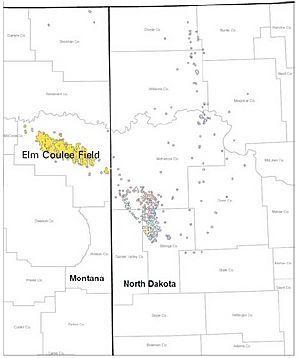
Oil fields were found in Montana after 1910. The oil went to small local refineries. They sold gasoline locally. After 1945, big companies like Standard Oil grew fast. By the 1950s, they owned most refining capacity. In 1949, Montana's oil value passed copper mining. After 1945, oil production grew in Alberta, Canada. Pipelines were built to Billings to serve the U.S. market.
The short-lived Williston Basin oil boom in the 1950s didn't help Montana refiners. Pipelines moved oil out of state. By 1960, Montana refiners relied on Canadian oil. By 2000, only four refineries remained. Production fell after peaking in 1968. New technology reduced jobs.
After oil was found in the Williston Basin, Glendive became an oil boom town. Small reserves and high transport costs ended the boom in 1954. In the 1970s, new discoveries created a second boom around Sidney. This boom also faded.
However, new drilling methods changed things. Horizontal drilling and fracturing technology made deep wells profitable. The discovery of the rich Elm Coulee Oil Field near Sidney in 2000 created a new boom. This field has billions of barrels of oil. High oil prices have fueled this new growth in the 21st century.
Dams and Hydropower: Harnessing Rivers
The need for electricity led to demand for hydropower. Montana's many rivers and natural resources were perfect for this. Many dams were built across the state. Most were on the Missouri River. The Montana Power Company owned and operated them. Great Falls became a center for hydropower. This was because of its natural waterfalls.
From 1933 to 1943, the U.S. Army Corps of Engineers built the Fort Peck Dam. It was on the Missouri River. It became the world's largest earthen dam. Its goals were flood control, irrigation, and hydroelectric power. It also provided jobs for 10,000 men during the Great Depression.
In the 1950s, Senator James E. Murray promoted federal hydropower. He secured funding for major dams in Montana. These included Canyon Ferry, Yellowtail, Hungry Horse, and Libby dams.
Montana Since 1945: Modern Changes
Montana has seen many changes since 1945.
Regional Shifts: Growth and Decline
Since the 1970s, western Montana has grown. Tourists, retirees, and wealthy part-time residents have moved there. They seek beautiful mountain scenery and outdoor activities. Housing prices soared. They dropped sharply during the 2008 recession.
At the same time, the economy shifted to services. Cities like Billings grew. It became a center for medicine and energy. In western Montana, Missoula grew due to higher education. Cities like Bozeman and Kalispell saw growth from tourism. Older mining towns like Butte and Anaconda shrank. After ARCO closed the Anaconda copper operations in 1980, the mines became a major cleanup site.
In the late 1900s and early 2000s, many small towns in eastern Montana lost people. But due to the Bakken oil region, towns like Sidney are booming. In 2012, Richland County, where Sidney is located, was one of the fastest-growing counties in the nation. Billings continues to grow. It serves as a hub for oil, coal, ranching, and farming.
Environmentalism: Protecting Montana's Beauty
[[Quote box | quote = We the people of Montana grateful to God for the quiet beauty of our state, the grandeur of our mountains, the vastness of our rolling plains, and desiring to improve the quality of life, equality of opportunity and to secure the blessings of liberty for this and future generations do ordain and establish this constitution. | source = —Preamble, 1972 Montana Constitution | font = 120% | width = 26em | align = right ]] Concern for the environment started early in Montana. In 1872, Yellowstone National Park was created. Part of it is in Montana. In the 1890s, George Bird Grinnell and Louis W. Hill helped create Glacier National Park. Congress set it aside in 1910. Hill, president of the Great Northern Railway, promoted the park. He built lodges and attracted many visitors.
The Civilian Conservation Corps (CCC) helped develop both Glacier and Yellowstone parks. This was from 1933 to 1942. CCC projects included planting trees, building campgrounds, and fighting fires.
Montana's 1972 state constitution focused on environmental protection. Its preamble talks about the importance of natural resources. It guarantees a clean and healthy environment as a right. There is often conflict between businesses and environmentalists. Businesses want to develop resources like coal and oil. Environmentalists want to protect scenery and wildlife. For example, when coal mining grew in eastern Montana, there was debate. People argued about using Yellowstone River water for power plants. Environmentalists, ranchers, and fishing groups opposed strip mining. They formed groups like the Northern Plains Resource Council. They also helped pass laws like Montana's Environmental Protection Act.
Higher Education: Learning for the Future
In 1994, Montana's public colleges and universities were reorganized. This was due to less state funding. Montana's 14 campuses were put into five groups. These included two state university systems: University of Montana and Montana State University. There was also a community college system, tribal colleges, and independent colleges.
Images for kids


